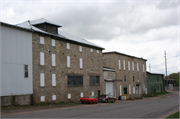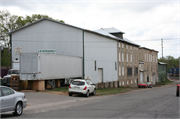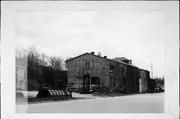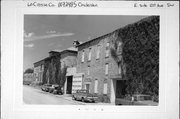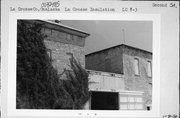Property Record
841 2ND AVE SW
Architecture and History Inventory
| Historic Name: | Onalaska Brewery |
|---|---|
| Other Name: | Onalaska Pickle and Canning Company |
| Contributing: | |
| Reference Number: | 72485 |
| Location (Address): | 841 2ND AVE SW |
|---|---|
| County: | La Crosse |
| City: | Onalaska |
| Township/Village: | |
| Unincorporated Community: | |
| Town: | |
| Range: | |
| Direction: | |
| Section: | |
| Quarter Section: | |
| Quarter/Quarter Section: |
| Year Built: | 1884 |
|---|---|
| Additions: | 1911C. 1920 1901 |
| Survey Date: | 19932015 |
| Historic Use: | industrial bldg/manufacturing facility |
| Architectural Style: | Side Gabled |
| Structural System: | |
| Wall Material: | Stone - Unspecified |
| Architect: | Joseph Burgermeister (builder) 1884 |
| Other Buildings On Site: | Y |
| Demolished?: | No |
| Demolished Date: |
| National/State Register Listing Name: | Not listed |
|---|---|
| National Register Listing Date: | |
| State Register Listing Date: |
| Additional Information: | A series of five buildings comprise what was, at its peak, the Onalaska Pickle & Canning Company complex. Four buildings line 2nd Avenue SW just north of the railroad tracks, while a fifth building is located at the rear (east). Of the four, connected, street-side buildings, the two center structures, built of limestone, are the oldest and date to 1884. The northern of the two stone structures rises four stories and is topped with a hipped roof. Much of the original six-bay window arrangement that is comprised of single openings that are each topped with a stone header remains intact; however, larger window openings now occupy part of the second floor. Most of the windows have been infilled with siding, while others have been infilled with stone. The southern stone building essentially rises three stories and is topped with a flat roof. Like the north building, each of the original window openings is topped with a stone header and many of the openings are infilled with vinyl siding. An overhead garage door opening has been placed along the first floor; a second overhead garage door is located in the one-story “connector” between the two buildings. The south, stucco-sheathed block (Ca. 1911) of the complex rises two stories and is topped with a low-pitched, gabled roof. Regular window openings are located along each level. Extending from the north end of the complex is a two--story, gabled block that is sheathed with metal (Ca. 1901 with later alterations). Finally, and although largely obscured from view, the one-story building (Ca. 1920) to the rear of the facility is faced with brick and features a stepped parapet on both ends. Although there are no known historic photos of the buildings when it served as a brewery, there are many images of the building while it served as a pickle factory. The subject stone buildings were built in 1884 and originally served as the Onalaska Brewery. Onalaska brewing history, however, began in the 1850s, with the arrival of the Gabriel Knecht family. At the age of sixteen, Gabriel Knecht immigrated to the United States with his family from Germany in 1846. While in Newark, New Jersey, he wed German-born Wilhelmina Hemel and in 1852 they moved to Wisconsin. The first record of Gabriel as residing in Onalaska is the 1860 census, which enumerates him, his wife and their five-year-old son Adolph as residing there. Gabriel is identified as a brewer. He died on 12 January 1866. Secondary accounts indicate that his wife (who is identified throughout her lifetime by various nicknames for Wilhelmina, such as Helen, Mena, Minnie and Amelia) ran the brewery, in association with a bar, restaurant and a hotel, which was managed by Milford G. Moore. Milford G. Moore was born in Maine in 1829 and, as of the 1860 census, was still recorded as living in his home state, where he worked as a farmer. After moving to Onalaska, he wed Wilhelmina Knecht in August 1867. As of the 1870 census, Milford is identified as both a hotel keeper and brewer, while “Mena” is noted as simply “keeping house.” In addition to her two children with Gabriel, she and Milford had a son, Frank, who was born in 1868. Little is known regarding actual beer production numbers for the brewery; however, as of 1879 (and prior to the subject facility being built), it is recorded as having produced/sold 660 barrels out of the total recorded 625,284 barrels produced in the state. Notably, of the total 218 breweries in the state in 1879, over half produced less than 500 barrels. As of 1880, Gabriel’s son Adolph was also working in the brewery, with fifty-one-year-old Milford continuing as brewer. Milford and Wilhelmina had also by then adopted a daughter, Pearl (age 12). Based on secondary accounts, it is believed that Milford continued to serve as brewer through the early 1880s. However, by 1885, an ad in the La Crosse City Directory, identifies Adolph as proprietor brewer and shipper of lager beer at the Onalaska Brewery. That directory also identifies La Crosse contractor and builder Joseph Burgermeister as responsible for the construction of the stone buildings. Adolph is also credited as having excavated the beer caves in the bluff, located east about one mile from the city, in Sand Lake Coulee (they remain extant). The brewery appears to have continued in operation under Knecht until sometime between 1888 and 1893. An 1891 Sanborn map indicates that the capacity of the brewery was 40 barrels. After briefly sitting idle, the brewery started up once again as of 1894, this time under the name of the Onalaska Brewing Company. Five La Crosse men, including C. Hafner, Emil Kohn, William Wuttke, Emil Bittner and Fred Schnell, ran the firm until its bankruptcy in 1899. The brewery had been associated with five Onalaska and La Crosse area saloons, the fixtures of which were being sold in order to pay off the brewery’s creditors. The J.S. Gedney Pickle Company, which was headquartered in Minneapolis, Minnesota, would purchase the former brewery buildings in 1901. Onalaska is noted as having been chosen for three reasons: good transportation facilities; the high quality of area vegetable crops; and the significant yield of area crops. The firm is identified as doing extensive remodeling to the buildings and installed machinery that was noted as worth $15,000. The first year of operation, the factory canned 1,200 cases of peas, 2,000 bushels of pickles, 3 tons of sauerkraut, along with some tomatoes. After five years of operation, the Gedneys pulled out of the firm and the company was renamed Onalaska Pickle and Canning Company, with Franklin L. Pierce serving as the new firm president (until his death in 1931). As of 1910, the total number of workers at the plant numbered 102, twenty-eight of which were women and two were under sixteen years of age. Improvements made to the facility by either Gedney or the Onalaska Pickle firm include the additions to both the north and south ends of the stone structures, as well as the one-story brick building that is located behind (east of) the original stone facility. They were completed as a result of the factory’s expanding canning operations, which were a result of expanding the territory from which they could get vegetables, It is noted that the original radius, covered by horse-drawn wagons, was approximately seven miles. Following the use of motorized trucks, that area was expanded to include the bulk of La Crosse County and into surrounding counties, as well as Minnesota. In addition to the purchase of produce from area farmers, the firm also operated (until 1952) their own farm east of Onalaska. The company reorganized in 1945 but continued operations until closing in 1957, at which time the company president was John Westerhouse. Despite closing, the property remained in the possession of the Onalaska Pickle & Canning Company into the 1980s. In 1963, the buildings were designated as one of two buildings in the city that were identified by the U.S. Army Corp of Engineers as fallout shelters, in the case of a warning or attack. Currently, the property is owned by D&M Recycling. |
|---|---|
| Bibliographic References: | Citations for 2016 Recommendation write-up below: “New York, Passenger Lists, 1820-1957,” Immigration records available online at www.Ancestry.com, Accessed July 2016; U.S. Federal Census, Population, 1860; Based on a 1907 citation regarding the existence of a brewery in Onalaska as of 1856, it is likely that is Knecht’s brewery, Bryant, ed., Memoirs of La Crosse County, 288; Dolbier, From Sawmills to Sunfish, 120; “Onalaska Canning Plant Closes, Offered for Sale,” The La Crosse Tribune, 24 September 1957, 10/7-10, includes photo and caption. A citation regarding the will of Gabriel Knecht was referenced online, however, it was not investigated for brewery-specific information, “Wisconsin Wills and Probate Records, 1800-1987, Wills, Vol. 1 and Vol. 3, 1866-1872, 1876-1879, Available online at www.Ancestry.com, Accessed July 2016. Gabriel Knecht is buried at the Onalaska City Cemetery, where his death date is identified as 1866. Please note that Gabriel’s death date is erroneously identified as 1863 in Franklin Curtiss-Wedge, comp., History of Clark County, Wisconsin (Chicago: H.C. Cooper Jr. & Co., 1918), 373. An 1881 biographical entry for Moore indicates that he came to Wisconsin in 1853, where he engaged in the lumber business. It is possible that he returned to Maine in the lumbering off-season, Butterfield, History of La Crosse County, Wisconsin (1881), 815. U.S. Federal Census, Population, 1860, 1870, 1880; Curtis-Wedge, History of Clark County, 1918, 373; “Brewing in Wisconsin Thirty-Six Years Ago,” in The Western Brewer: and Journal of the Barley, Malt and Hop Trades (Chicago, IL), November 1915, 178-179. The 1881 biographical entry for Milford Moore notes him as brewer in 1881, Butterfield, History of La Crosse County (1881), 815; Dolbier, From Sawmills to Sunfish, 120; La Crosse City Directory, 1885, 96, 124; Although secondary accounts note an 1890 closing of the brewery (and the 1891 Sanborn map includes a note that the brewery had closed three years earlier, thus indicating that it had closed in 1888), Adolph Knecht continues to be identified as a brewer in Onalaska as of the 1891-1892 state gazetteer; however, by the 1893 city directory, he is no longer listed as residing in Onalaska, Wisconsin State Gazetteer and Business Directory, 1891-92 (Chicago: R. L. Polk & Co., 1891), 804; La Crosse City Directory, 1893 (includes Onalaska directory), 480-482; Sanborn Map Company, Fire Insurance Map of Onalaska, WI (New York: Sanborn Map Company, 1887, 1891, 1894); Eighth Biennial Report of the Bureau of Labor and Industrial Statistics, State of Wisconsin, 1897-98 (Madison, WI: Democrat Printing Co., 1899), 417; “Onalaska Canning Plant Closes, Offered for Sale”; “60 Years Ago,” The La Crosse Tribune, 26 July 1959, 10/6-9; “Federal Bankruptcy Act,” The Wall Street Journal (New York, NY), 19 August 1899, 5/3. Dolbier, From Sawmills to Sunfish, 128; Financial Ledgers of the Gedney firm are available at the La Crosse Public Library Archives, however, they were not reviewed for purposes of this document, Gedney Pickle Company Financial Ledger, 1901-1905, MISC MSS 253, La Crosse Public Library Archives, La Crosse, WI. J.D. Beck, et. al., Fourteenth Biennial Report of the Bureau of Labor and Industrial Statistics, State of Wisconsin, 1909-1910 (Madison, WI: Democrat Printing Company, 1911), 693; “Onalaska Canning Plant Closes, Offered for Sale”; Dolbier, From Sawmills to Sunfish, 128-129. “County by County Listing,” The La Crosse Tribune, 6 January 1963, 4/3; Onalaska Pickle & Canning Company to Alberta Pertzsch, Warranty Deed, 18 June 1986, 762/89, #977639. |
| Wisconsin Architecture and History Inventory, State Historic Preservation Office, Wisconsin Historical Society, Madison, Wisconsin |

